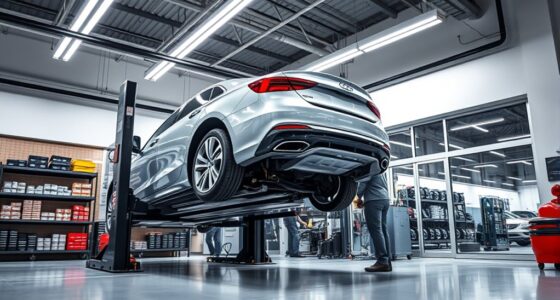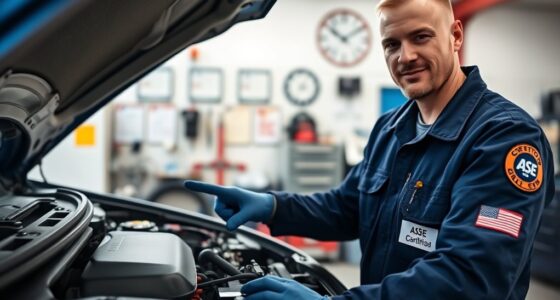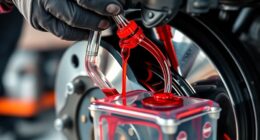Dealer maintenance plans provide manufacturer-backed coverage with genuine parts and expert service, helping you keep your vehicle under warranty and retaining its resale value. Independent shops often offer more flexibility and lower prices but may have varied warranty guarantees. While dealer plans ensure your repairs meet manufacturer standards, independents might use OEM or aftermarket parts. To decide what’s best, consider your priorities—warranty protection, costs, or flexibility—and explore the key differences that could impact your vehicle’s care.
Key Takeaways
- Dealer plans typically include manufacturer-backed warranty coverage with genuine OEM parts and expert service.
- Independent shops often offer more flexible, cost-effective pricing but may have variable warranty coverage.
- Dealer maintenance ensures vehicle warranty preservation and resale value through manufacturer standards.
- Independent shops can provide customized services and lower prices, but warranty terms and parts quality should be verified.
- Both options require understanding warranty coverage, parts quality, and service guarantees before proceeding.

When it comes to maintaining your vehicle, you have two main options: sticking with dealer maintenance plans or choosing independent shops. Each approach offers distinct advantages, especially when it comes to warranty coverage and pricing structures. Understanding these differences helps you make an informed decision that suits your budget and peace of mind.
Dealer maintenance plans often include warranty coverage that’s specifically aligned with your vehicle’s manufacturer. This means any repairs or services performed under the plan are typically backed by the manufacturer’s warranty, giving you confidence that genuine parts and expert service will be used. If your vehicle is still under the original warranty, this coverage can be a significant benefit, protecting you from unexpected expenses down the road. Plus, dealer plans are designed to meet the manufacturer’s standards, ensuring your car receives the proper care to maintain its warranty status and resale value.
Dealer plans include manufacturer-backed warranty coverage, ensuring genuine parts and expert service to protect your vehicle’s value.
Pricing structures at dealerships tend to be transparent but can be higher compared to independent shops. Many dealerships offer flat-rate packages for routine services like oil changes, brake inspections, and tire rotations, which can simplify budgeting. However, these packages sometimes come with a premium, reflecting the use of original equipment manufacturer (OEM) parts and dealership-trained technicians. While this might seem costly, some car owners prefer the reassurance that comes with dealer-authorized service and the potential for seamless warranty claims.
On the other hand, independent shops usually have more flexible pricing structures. They often offer competitive rates because they operate with lower overhead costs and can source parts from a variety of suppliers. Independent mechanics might also provide custom packages tailored to your specific needs, potentially saving you money. However, warranty coverage at these shops varies. While many independent shops honor manufacturer warranties if they use OEM parts, some may only offer limited guarantees on their work or parts. It’s essential to clarify what warranty coverage is included before proceeding with any service.
Frequently Asked Questions
Can I Switch Between Dealer and Independent Shop Maintenance Plans?
Yes, you can switch between dealer and independent shop maintenance plans, but it depends on the service plan flexibility and switching policies of your current plan. Check with your dealer or shop first, as some may have restrictions or require a waiting period. Make sure to review any cancellation fees or transfer options to guarantee a smooth transition. Being informed helps you choose the best plan for your vehicle’s needs.
Do Dealer Plans Cover Aftermarket or Non-Oem Parts?
Dealer plans typically don’t cover aftermarket or non-OEM parts, as they focus on original manufacturer components. For example, if you replace a brake pad with an aftermarket part, the dealer may deny coverage for related repairs. Always check your plan’s terms, since some may exclude non-OEM parts explicitly. If you prefer aftermarket parts, consider independent shops that often provide more flexible coverage options for non-OEM components.
How Do Service Turnaround Times Compare Between Dealers and Independents?
You’ll find that dealer service turnaround times often have slower service speed due to higher appointment availability demand and more extensive checks. Independent shops tend to offer quicker service, with shorter wait times, because they usually have more flexible scheduling and fewer bureaucratic processes. If quick turnaround is your priority, independents might be the better choice, but if you prefer thorough, factory-trained technicians, dealers may take a bit longer.
Are There Any Hidden Fees in Maintenance Plans?
Back in the day, savvy car owners knew to read the fine print carefully. Hidden charges can lurk in maintenance plans, so you should watch out for service exclusions and any fine print. Some plans might include hidden fees for parts or services not clearly outlined upfront. Always ask for a detailed breakdown to avoid surprises, ensuring you’re aware of any potential extra costs before committing to a plan.
What Is the Process for Filing a Warranty Claim?
To file a warranty claim, start by reviewing the warranty procedures provided by your dealer or manufacturer. You’ll need to gather claim documentation such as proof of purchase, detailed descriptions of the issue, and photos if applicable. Submit these materials to your dealer or warranty provider, either online or in person. They’ll review your documentation, verify coverage, and guide you through the next steps for repair or replacement.
Conclusion
Ultimately, choosing between dealer maintenance plans and independent shops is like picking your favorite coffee spot—you’ll find what suits your taste and budget best. Both options aim to keep your car running smoothly, just with different flavors of service. Trust your instincts, consider your needs, and enjoy the journey. After all, a well-cared-for car makes every drive a little more enjoyable—so go ahead, pick what feels right and keep on cruising!








